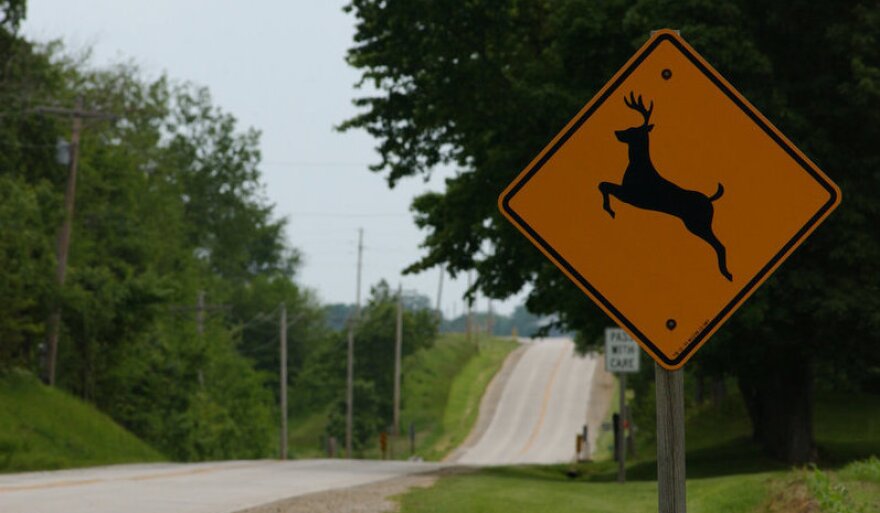This story originally aired on March 7, 2019 and it aired again most recently in the December 7, 2023 episode of Crosscurrents.
California is home to lots of wild animals, but one of the most likely places to encounter them is on the road. Thousands of collisions are reported every year, and some of the deadliest stretches of highway are here in the Bay Area.
It’s Saturday, just after 5 a.m., and Kathryn Harrold is looking for dead animals. She cruises down the Peninsula in a small tan 4-door sedan. A dashcam hangs from her rearview mirror fixed on the beams of her headlights. Her eyes scan left to right, searching for anything weird on the road.
Kathryn is one of hundreds of citizen scientists in the Bay Area who help document roadkill. She works nights at a bar in San Francisco and lives in the South Bay. So her commute is perfectly timed after nightfall when most animals get hit, but before highway clean-up crews pick up the carcasses. If something is really dangerous, she’ll call it in to the highway patrol.
A database for roadkill
Kathryn is sort of the ultimate concerned citizen. When she gets home she enters each animal into the California Roadkill Observation System, a crowd-sourced database that maps roadkill all over the state. Want to know where you’re most likely to hit a skunk? There’s a map for that. Want to see where beavers, raccoons, or river otters get hit? There’s a map for that, too. Animals that we rarely see — mountain lions, porcupines, even an elephant seal — have been hit on California roads and logged in the database.
Over the past decade, contributors like Kathryn have posted almost 60,000 records of animals killed on the road, complete with sometimes gruesome photos. She tells me about a buck that she thinks got hit by an 18 wheeler.
“It removed the entire bottom half of this buck,” she says. “And all of its rib cage and intestines were just still intact on the upper part of the body. Like where did the lower half go? I have no idea.”

The database was created by scientists at UC Davis. Now, with a decade of roadkill data analyzed, they know that some of the highways with the most roadkill in the state are here in the Bay Area; 101 in Marin, 580 in the East Bay. Among the very worst is the stretch of highway 280 that runs down the Peninsula, the same route Kathryn takes day after day. There’s a lot of undeveloped land on either side of the freeway; rolling hills on one side, a reservoir surrounded by forests on the other. It’s great habitat for animals, except they have to dodge eight lanes of traffic to use it. That’s bad for animals, but it’s really dangerous for drivers, too.
Dangers to drivers
“Some people instinctively swerve,” says Kathryn. “And then when you're going 65 to 80 miles an hour and you just yank your wheel 15 degrees you're going to fly off the road and a lot of people do and they die.”
And that’s the thing. Vehicles and animals are a bad combination. The human cost is high — in clean-up, property damage, injuries, and even death. The Road Ecology Center at UC Davis released a report last year adding up all these costs. Based on insurance claims, they estimate that in one year, roadkill in California costs more than $300 million.
Fraser Shilling, the director of the Road Ecology Center, says “[That estimate] doesn't tell us about the ecological or conservation impacts. It tells us just about the impacts to people, to society. But often that's the thing that gets the government to respond.”
In last year’s report, he recommends building structures like underpasses and overpasses. And putting up fencing to prevent large animals like deer from getting onto the road in the first place. According to the Center for Biological Diversity, structures like these in other states have reduced roadkill by 80–96%. Putting up fencing along 280 wouldn’t be cheap, but Fraser says it’s cheaper than all these accidents.
“Our estimate was it would pay for itself in a year, which is really fast.”
Over the years, Caltrans has acknowledged the problem. And there has been some movement: the agency approved a $12 million underpass on Highway 17 near Santa Cruz. And in Southern California, there are plans for a $60 million wildlife overpass to help mountain lions and deer cross. Most of that would be privately funded.
A steadfast advocate
So far no such project has been planned for 280, but citizen scientist Kathryn Harrold is trying to change that. In order to communicate the severity of the issue to Caltrans, she’s been reading through records of all the drivers that have died there in recent years. But this work takes an emotional toll.
“It's seriously hard reading people's obituaries,” she says. “It's totally brutal. And it's just it's so it's fixable.”
Still, Kathryn’s motivated. What started as a casual observation of a problem has turned into a calling. After she spent years writing to Caltrans and pressing for change, Kathryn started working with the Road Ecology Center as a consultant. When she isn’t logging animals in the database or reaching out to state representatives, she’s teaching herself how to scrape collision data from the California Highway Patrol website, and working toward an environmental science degree.
“I never really wanted to be an expert in road kill. But it just kind of happened as they've taken so long to fix the problem. I just kept learning more and more.”
Kathryn says she doesn’t plan on stopping until all of our highways are safe for people and for animals. And that might take a while. In the meantime, she keeps her dash cam running.
Want to learn how you can contribute data to the California Roadkill Observation System? Head to wildlifecrossing.net/california to learn more.






